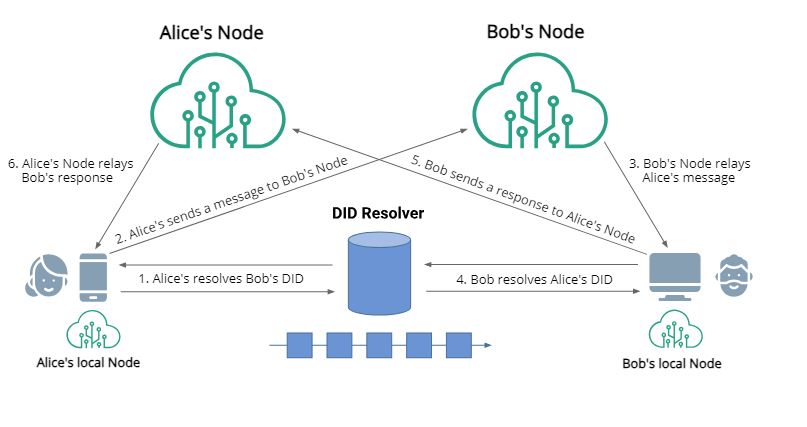Decentralized Web Nodes- Democratizing Web Data from being just User Generated to being User Controlled.
 Uche Otakpor
Uche Otakpor
The World Wide Web or Internet as we know it today is tagged Web 2.0, an upgrade from the static and stale Web 1.0 where information shared on the web was entirely owned and controlled by Web domain owners. With Web 2.0 ordinary users could interact with the Web, communicate and most of all share their own information on the Web without necessarily owning domains, this revolution pioneered by the advent of the earliest social media platforms like Windows messenger, 4chan, Myspace and then the popular Facebook, brought much needed dynamism to the internet and was a big leap in bringing more web access to the world.
So let's say I'm new to Instagram and want to create an account, I click on the "Sign Up" icon, I'm asked to input my First and Last names, to create a password, create a username and upload a Profile Pic, all this information I'm imputing is what Instagram would use to build my Profile & give me an identity on the App, but now we have to wonder where does all that information go? Since my presence on the platform would be continuous, then obviously the information I imputed during sign-up and subsequently with Posts, DMs, comments and even indirect-interactive information such as likes, saves & shares have to kept somewhere to continue to build and update my identity on the platform, right? The advent of the Interactive Web 2.0 meant ordinary web users could share information across the internet, but all that data had to be stored somewhere to preserve the user's presence on the web, the need for this led to the rise of centralized Data Storage Systems/Servers usually managed and controlled by Internet service Institutions and Companies like Meta, the parent company of Instagram. You see when you open an account on Instagram and input the required information , Instagram collects all that information and stores them in Databases owned by their parent company Meta, so when next you want to use the app, it will use your authentication information (Username/Email and Password) to authenticate and reference your data on their servers, log you in and then build up your profile. But there's a slight issue with this method of Data Management, the thing is even though you created the data and in theory it should belong to you the reality is that it doesn't. Because of the centralized and institutionalized nature of current Data Management methods, all the data you create on any internet platform is owned and controlled by those platforms allowing them to do whatever they want they want to do with the data, with or even without your consent. Those platforms can also choose restrict a users access to their data, like Instagram or Facebook banning you when you violate their Community Guidelines.
The Advent of Web 3.0 brought about the concept of "Decentralized Web Nodes (DWNs)" intended to remove central control and management from one single Server to multiple distributed Servers called Nodes. Web 3.0 is built on the Blockchain Technology which is a type of Encryption System that creates an immutable stack of stored data, with new data being encrypted with information from the previous data. The Idea of Web 3.0 is to restore the original principles of the web, such as privacy and security powered by the blockchain encryption system, user empowerment by removing central collection and control of data and giving each user the sole authority of their data, openness and democratization of the internet by using a consensus protocol for data control and management.
The general Idea for Distributed Web Nodes(DWNs) is that they are personalized Servers called Nodes that represent database(s) tied to, managed and controlled by a single user, the DWNs work to be a one-stop trans-platform repository for storing a user's data to be used anywhere in the web. To simplify, think of DWNs as a database that contains every of your digital information, the database would be controlled by you, so instead of the traditional method of you submitting your information to a central server controlled by Instagram/Meta, they would instead send retrieval requests to your DWNs to be able to get your information to use on their platform, the DWN would also work across platforms, so instead of you recreating the same login information from Instagram, to Facebook, to Snapchat and X, you would only need to create it once and store it in your DWN, so those apps would write to your DWN to retrieve the info whenever you want to use them. Distributed Web Nodes are linked to Decentralized Identifiers or DIDs which are alphanumeric identification tokens that are unique to every user and their DWNs.
Decentralized Identifiers like DWNs is also a blockchain based concept and to expatiate they are self-sovereign identifiers that are used to authenticate ownership of a digital asset which in this case are the DWNs, so to put it plainly DIDs are a unique identification tag for you that doubles as the web address to your DWNs. DIDs are split into three parts, the first is the URI scheme identifier , which is used to identify the subject URL and the kind of protocol it runs under, think of "https" that you see on everyday weblinks as a type of URI scheme identifier, for DIDs this part is simply "did", the second part of a DID is the Method Identifier, this indicates the method that defines the DID's C.R.U.D operations, C.R.U.D stands for "Create, Read, Update, Delete" so basically the Method Identifier is used to identify the kind of method that determines how the DID would be used on the web, the last part of the DID is the Method specific identifier, this is a is a unique string that is generated and interpreted by the DID method. The image below visualizes the different parts of a DID. [Image source: https://developer.tbd.website/blog/what-is-web5/ ]

As previously stated the DIDs work as addresses to a user's DWN which means, a user would store information on their DWN and would use their DID to locate and retrieve their info, note that the DWNs can either be a single node or group of synced nodes which would all contain the user's data and all of them would be identified by a single DID. DIDs are also linked to DID Documents, which contain protocols on how to communicate and interact with the DID owner, such as public keys, service endpoints and verification methods. The DIDs are a lot of times anchored on a blockchain, but this is not mandated as they can be anchored on any other encryption system or not even anchored at all and they'll still work, the DID Documents are hosted on decentralized storage systems like IPFS, Bit-Torrent or File-coin while the DWNs can be hosted on or across a user's local devices or even on dedicated hosting platforms while still being controlled by the user. The user can decide how and where to store their data, and can transfer their data to different nodes without losing access or control, they can also set the rules and conditions for who can access their data, by using encryption and access policies. DWNs also ensure the security and availability of the data, by using methods such as signing, encryption, hashing, and replication, they can also be used to send and receive messages between different DIDs, such as requests, responses, notifications, or invitations and they support different types of data and messages, such as plain text, video, audio, JSON, or encrypted formats, this paves the way for applications like decentralized social media where DID authenticated users can connect with each other without any central intermediary.

In conclusion, Decentralized Web Nodes are intended to provide Data sovereignty, integrity and availability, remove the centralized bottle-necks of institutionalized data management and control and to restore the original principles for the Web which is openness, privacy and user empowerment.
Subscribe to my newsletter
Read articles from Uche Otakpor directly inside your inbox. Subscribe to the newsletter, and don't miss out.
Written by
